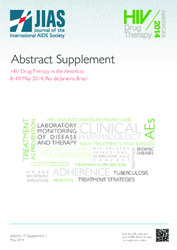Please use this identifier to cite or link to this item:
http://cris.unibe.edu.do/handle/123456789/51| Title: | High-risk HPV genotypes and anal and cervical dysplasia among HIV(+) women, Dominican Republic [abstract] | Autores: | Paulino-Ramírez, Robert Garrido, Luis Eduardo Fernández, Alejandro Gómez, Natalia Tejada, J. C. |
Researchers (UNIBE): | Paulino-Ramírez, Robert Garrido, Luis Eduardo Fernández, Alejandro Gómez, Natalia |
Affiliations: | Instituto de Medicina Tropical y Salud Global (IMTSAG) Decanato de Investigación e Innovación (DII) Facultades / Departamentos Académicos UNIBE Facultades / Departamentos Académicos UNIBE |
Research area: | Ciencias de la Salud | Keywords: | Human Papilloma Virus (HPV); Human Immunodeficiency Virus (HIV) | Issue Date: | 2014 | Publisher: | International AIDS Society (IAS) | Source: | Journal of the International AIDS Society, 17 (Suppl. 1). P16 | Journal: | Journal of International AIDS Society | Volume: | 17 (Suppl. 1) | Issue: | P16 | Conference: | HIV Drug Therapy in the Americas (2014) | Abstract: | Introduction: Human papilloma virus (HPV) has been linked to anal, penile and cervical cancers [1]. HPV can be classified as highlyoncogenic or low-oncogenic depending on strains related to cellular modifications induced by direct invasion of basal membrane in skin. When compared with HIV-uninfected women, women with HIV have higher rates of HPV infection and cervical dysplasia [2,3]. Materials and methods: Participants were selected depending on past clinical history of cervical cytological modifications. All patients were screened with cervical and anal samples with cytobrush and molecular analysis with HPV genotype assays. Results: Fifteen percent reported having anal sex with their sexual partners. Retro-prospective and prospective analysis of cervical Paps mear results revealed cervical intraepithelial neoplasia (CIN) rangingfrom I to III, CIN-I (n=52), CIN-II (n=32) and CIN-III (n=16). Those findings were detected in a mean of one year. Cytological analysis of anal samples reported six cases of Anal Intraepithelial Neoplasia(AIN) grade I (n=6) and/or koilocytes (n=14); the correlation of AIN-I and Koilocytes was in a ratio of 6:14. Of these 14 cases, onlyone reported having anal intercourse. In the molecular analysis,we found that HPV16 was detected in 35 cases in either CIN-III/II/I,HPV18 in 21 cases of CIN, HPV45 was detected in six cases of CIN and four in AIN-I/Koilocytes, meanwhile HPV51, 52 and 68 were only detected among those with AIN-I/Koilocytes in anal epithelium. |
URI: | https://cris.unibe.edu.do/handle/123456789/51 | DOI: | 10.7448/IAS.17.2.19119 |
| Appears in Collections: | Publicaciones del IMTSAG-UNIBE Publicaciones indexadas en Scopus / Web of Science |
Files in This Item:
| File | Description | Size | Format | |
|---|---|---|---|---|
| IAS.17.2.19180.pdf | Full text [open access] | 1.83 MB | Adobe PDF |  View/Open |
Items in DSpace are protected by copyright, with all rights reserved, unless otherwise indicated.
